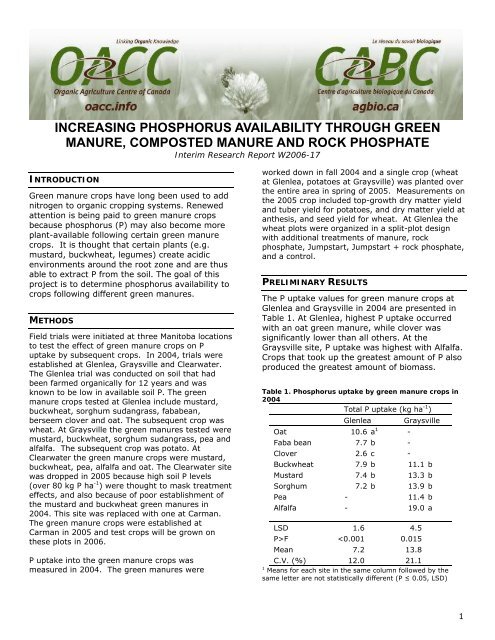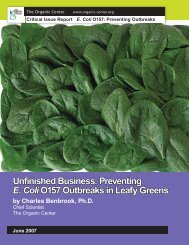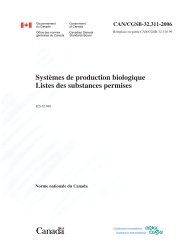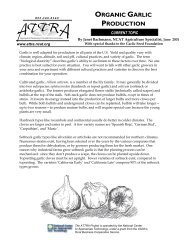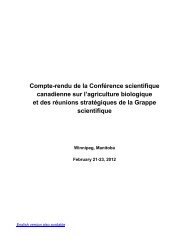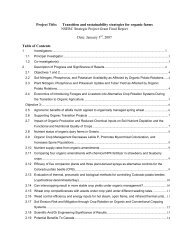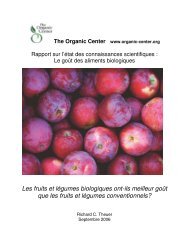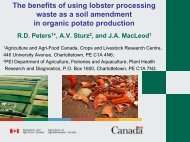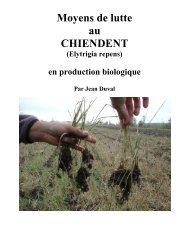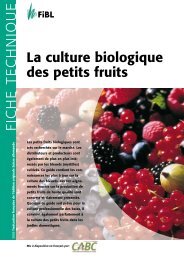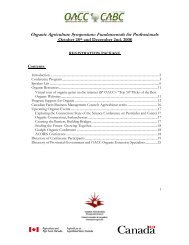Increasing phosphorus availability through green manure ...
Increasing phosphorus availability through green manure ...
Increasing phosphorus availability through green manure ...
Create successful ePaper yourself
Turn your PDF publications into a flip-book with our unique Google optimized e-Paper software.
INCREASING PHOSPHORUS AVAILABILITY THROUGH GREEN<br />
MANURE, COMPOSTED MANURE AND ROCK PHOSPHATE<br />
Interim Research Report W2006-17<br />
INTRODUCTION<br />
Green <strong>manure</strong> crops have long been used to add<br />
nitrogen to organic cropping systems. Renewed<br />
attention is being paid to <strong>green</strong> <strong>manure</strong> crops<br />
because <strong>phosphorus</strong> (P) may also become more<br />
plant-available following certain <strong>green</strong> <strong>manure</strong><br />
crops. It is thought that certain plants (e.g.<br />
mustard, buckwheat, legumes) create acidic<br />
environments around the root zone and are thus<br />
able to extract P from the soil. The goal of this<br />
project is to determine <strong>phosphorus</strong> <strong>availability</strong> to<br />
crops following different <strong>green</strong> <strong>manure</strong>s.<br />
METHODS<br />
Field trials were initiated at three Manitoba locations<br />
to test the effect of <strong>green</strong> <strong>manure</strong> crops on P<br />
uptake by subsequent crops. In 2004, trials were<br />
established at Glenlea, Graysville and Clearwater.<br />
The Glenlea trial was conducted on soil that had<br />
been farmed organically for 12 years and was<br />
known to be low in available soil P. The <strong>green</strong><br />
<strong>manure</strong> crops tested at Glenlea include mustard,<br />
buckwheat, sorghum sudangrass, fababean,<br />
berseem clover and oat. The subsequent crop was<br />
wheat. At Graysville the <strong>green</strong> <strong>manure</strong>s tested were<br />
mustard, buckwheat, sorghum sudangrass, pea and<br />
alfalfa. The subsequent crop was potato. At<br />
Clearwater the <strong>green</strong> <strong>manure</strong> crops were mustard,<br />
buckwheat, pea, alfalfa and oat. The Clearwater site<br />
was dropped in 2005 because high soil P levels<br />
(over 80 kg P ha -1 ) were thought to mask treatment<br />
effects, and also because of poor establishment of<br />
the mustard and buckwheat <strong>green</strong> <strong>manure</strong>s in<br />
2004. This site was replaced with one at Carman.<br />
The <strong>green</strong> <strong>manure</strong> crops were established at<br />
Carman in 2005 and test crops will be grown on<br />
these plots in 2006.<br />
P uptake into the <strong>green</strong> <strong>manure</strong> crops was<br />
measured in 2004. The <strong>green</strong> <strong>manure</strong>s were<br />
worked down in fall 2004 and a single crop (wheat<br />
at Glenlea, potatoes at Graysville) was planted over<br />
the entire area in spring of 2005. Measurements on<br />
the 2005 crop included top-growth dry matter yield<br />
and tuber yield for potatoes, and dry matter yield at<br />
anthesis, and seed yield for wheat. At Glenlea the<br />
wheat plots were organized in a split-plot design<br />
with additional treatments of <strong>manure</strong>, rock<br />
phosphate, Jumpstart, Jumpstart + rock phosphate,<br />
and a control.<br />
PRELIMINARY RESULTS<br />
The P uptake values for <strong>green</strong> <strong>manure</strong> crops at<br />
Glenlea and Graysville in 2004 are presented in<br />
Table 1. At Glenlea, highest P uptake occurred<br />
with an oat <strong>green</strong> <strong>manure</strong>, while clover was<br />
significantly lower than all others. At the<br />
Graysville site, P uptake was highest with Alfalfa.<br />
Crops that took up the greatest amount of P also<br />
produced the greatest amount of biomass.<br />
Table 1. Phosphorus uptake by <strong>green</strong> <strong>manure</strong> crops in<br />
2004<br />
Total P uptake (kg ha -1 )<br />
Glenlea Graysville<br />
Oat 10.6 a 1 -<br />
Faba bean 7.7 b -<br />
Clover 2.6 c -<br />
Buckwheat 7.9 b 11.1 b<br />
Mustard 7.4 b 13.3 b<br />
Sorghum 7.2 b 13.9 b<br />
Pea - 11.4 b<br />
Alfalfa - 19.0 a<br />
LSD 1.6 4.5<br />
P>F
Table 2. Wheat dry matter and grain yields from wheat crops grown with different amendments and preceding <strong>green</strong><br />
<strong>manure</strong> crops at Glenlea in 2005<br />
Green Manure Crop Oat Buckwheat Faba bean Mustard Sorghum Clover<br />
Subplot Dry Matter (t ha -1 )<br />
control 2.35 2.79 2.87 3.46 2.17 3.14<br />
<strong>manure</strong> 2.19 2.47 3.58 3.24 2.71 3.90<br />
rock phosphate 2.20 2.45 2.81 3.67 2.31 3.78<br />
Jumpstart 2.25 2.57 2.90 4.00 2.00 3.75<br />
Jumpstart + rock P 2.03 2.63 3.46 3.72 1.72 2.75<br />
Grain Yield (t ha -1 )<br />
control 1.15 1.14 1.23 1.13 0.88 1.09<br />
<strong>manure</strong> 1.03 1.42 1.43 1.30 1.08 1.35<br />
rock phosphate 0.98 1.29 1.39 1.07 1.12 1.34<br />
Jumpstart 0.93 1.30 1.10 1.07 0.84 1.05<br />
Jumpstart + rock P 0.96 1.10 1.31 0.93 0.92 1.20<br />
Mustard <strong>green</strong> <strong>manure</strong> appeared to be most<br />
beneficial for wheat dry matter production, but<br />
faba bean appeared to be better for grain yield in<br />
the following wheat crop in this trial. Preliminary<br />
results suggest that composted beef cattle<br />
<strong>manure</strong> following buckwheat, faba bean or<br />
clover, and rock phosphate following faba bean or<br />
clover may be beneficial for wheat grain yield.<br />
Soil amendments were least beneficial following<br />
oat <strong>green</strong> <strong>manure</strong>. The addition of Jumpstart to<br />
rock P did not improve grain yield.<br />
Alfalfa <strong>green</strong> <strong>manure</strong> was superior to sorghum<br />
<strong>green</strong> <strong>manure</strong> for potato tuber production in the<br />
following year.<br />
This study suggests that <strong>green</strong> <strong>manure</strong>s differ in<br />
<strong>phosphorus</strong> uptake, but that this does not<br />
necessarily determine their relative benefit to<br />
succeeding crops. Soil amendments were variably<br />
effective, with the greatest relative advantage<br />
probably due to <strong>manure</strong>.<br />
THE BOTTOM LINE…<br />
Green <strong>manure</strong>s including buckwheat,<br />
mustard, faba bean, pea and clover<br />
provided benefits in wheat and potato<br />
production. Manure and rock P showed<br />
potential for increasing yields.<br />
ACKNOWLEDGEMENTS<br />
Farmer Collaborators: Kroeker Potato Farms,<br />
MB and R. Guilford, Clearwater MB<br />
Table 3. Potato yields at Graysville in 2005<br />
Topgrowth<br />
Dry Matter<br />
Tuber Yield<br />
kg ha -1<br />
Alfalfa 834 a 1 8079 a<br />
Mustard 716 ab 6245 ab<br />
Pea 646 ab 6041 ab<br />
Buckwheat 580 ab 5650 ab<br />
Sorghum 489 b 4931 b<br />
LSD 378 2669<br />
P>F 0.061 0.044<br />
Mean 670 6218<br />
C.V (%) 35.17 26.7<br />
1 Means in the same column followed by the same letter are<br />
not statistically different (P ≤ 0.05, LSD)<br />
CREDITS<br />
Martin Entz (University of Manitoba), Brenda Frick<br />
(OACC), Matthew Wiens (University of Manitoba) and<br />
Roxanne Beavers (OACC, ed.)<br />
FUNDING<br />
Agri-Food Research & Development Initiative<br />
(Manitoba)<br />
For more information:<br />
Visit oacc.info or contact us at:<br />
University of Saskatchewan<br />
51 Campus Dr., Saskatoon SK S7N 5A8<br />
Tel: (306) 966-4975 Fax: (306) 966-5015<br />
Email: organic@usask.ca<br />
2


